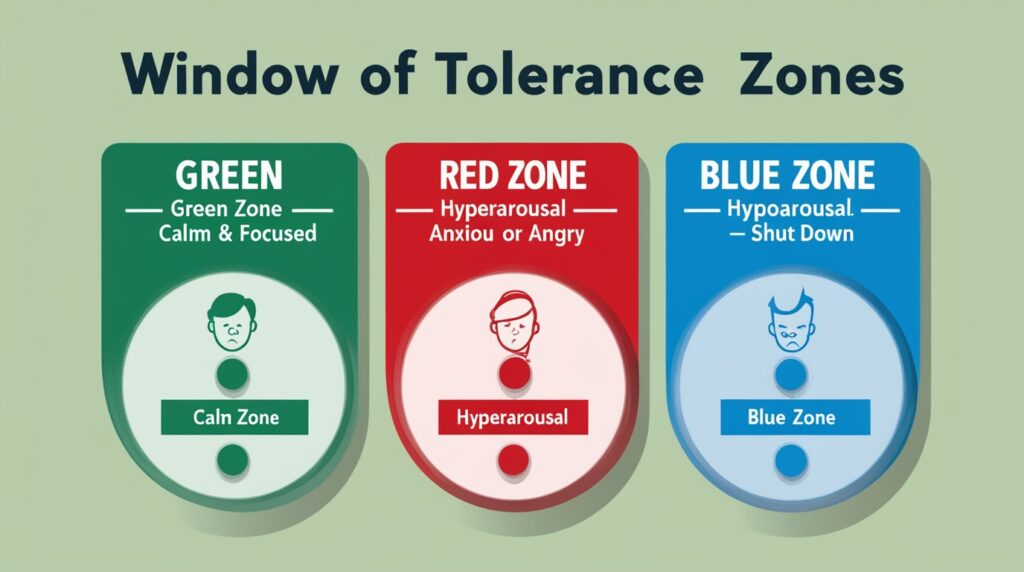Window of Tolerance Worksheet: A Complete Guide to Emotional Regulation
Window of Tolerance Worksheet: A Complete Guide to Emotional Regulation
Understanding the window of tolerance is essential for maintaining emotional balance, mental clarity, and resilience in daily life. This powerful concept, developed by Dr. Dan Siegel, describes the optimal zone in which we can function effectively—where we can think clearly, respond rationally, and manage stress without being overwhelmed or shut down. In this article, we present a comprehensive Window of Tolerance worksheet to help you identify, expand, and regulate your emotional state for improved mental health and well-being.
What Is the Window of Tolerance?
The Window of Tolerance refers to the emotional zone where a person can manage life’s challenges without becoming dysregulated. Within this window, the nervous system is balanced, allowing for clear thinking, self-control, and emotional stability.
When someone moves outside their window, they may experience:
- Hyperarousal – feeling anxious, panicky, or overwhelmed (fight-or-flight response)
- Hypoarousal – feeling numb, detached, or emotionally shut down (freeze response)
By learning to recognize when you are within or outside your window, you can use strategies to bring yourself back into balance.
Why the Window of Tolerance Matters

Operating within your Window of Tolerance means being in your optimal performance state. It’s where you can:
- Think logically and make decisions clearly
- Maintain emotional balance under stress
- Connect meaningfully with others
- Recover quickly from difficulties
When outside of it, even small challenges can feel impossible, leading to poor decisions, emotional outbursts, or avoidance behaviors.
The Science Behind the Window of Tolerance
The concept is rooted in polyvagal theory and trauma research, focusing on how the autonomic nervous system responds to stress. The sympathetic nervous system activates the body to fight or flee during danger, while the parasympathetic system calms and restores it. Trauma, chronic stress, or anxiety can shrink one’s window, making it harder to stay regulated.
Fortunately, the window can be expanded through awareness, mindfulness, and self-regulation techniques, which we will explore in the following sections.
Window of Tolerance Worksheet: Step-by-Step Guide
This worksheet helps you track your emotional states, identify triggers, and develop strategies to stay within your optimal zone.
Step 1: Identify Your States
| State | Description | Emotions/Behaviors | Physical Sensations |
|---|---|---|---|
| Within the Window (Optimal Zone) | Calm, focused, emotionally balanced | Motivated, clear-headed, connected | Steady heartbeat, relaxed muscles |
| Hyperarousal (Fight/Flight) | Overactivated, anxious, or angry | Restlessness, panic, irritability | Racing heart, sweaty palms, tight chest |
| Hypoarousal (Freeze) | Underactivated, numb, or disconnected | Withdrawal, fatigue, dissociation | Low energy, shallow breathing, heaviness |
Reflect on how each state feels for you. Recognizing these cues is the foundation of self-regulation.
Step 2: Recognize Your Triggers
Write down what situations, people, or memories push you out of your window.
Examples:
- Criticism or rejection
- Work overload
- Conflict with loved ones
- Sudden changes or uncertainty
By identifying your emotional triggers, you gain the ability to prepare and respond more consciously next time they appear.
Step 3: Develop Grounding Strategies
To stay within your Window of Tolerance, you need tools to bring yourself back from hyperarousal or hypoarousal.
For Hyperarousal (Calming the System)
- Deep breathing (e.g., box breathing 4x4x4x4)
- Mindful grounding (5-4-3-2-1 sensory exercise)
- Progressive muscle relaxation
- Gentle yoga or stretching
- Writing or journaling emotions
For Hypoarousal (Energizing the System)
- Physical movement or light exercise
- Listening to upbeat music
- Taking a cold shower
- Talking with a trusted friend
- Setting small achievable tasks
Using these techniques regularly strengthens your nervous system’s flexibility.
Step 4: Track Your Daily Emotional State
Use this daily tracker to observe patterns and progress.
| Date | Event/Trigger | State (Within/Hyper/Hypo) | Response Used | Outcome |
|---|---|---|---|---|
| 10/12/2025 | Argument with coworker | Hyperarousal | Deep breathing | Calmed within 10 mins |
| 10/13/2025 | Quiet evening alone | Within window | Mindful journaling | Felt relaxed and present |
This practice increases self-awareness and helps you develop a personalized emotional regulation toolkit.
Step 5: Expand Your Window of Tolerance
You can train your nervous system to tolerate more stress without becoming dysregulated.
Here’s how:

- Mindfulness and Meditation – Regular mindfulness practices calm the mind and expand emotional resilience.
- Body Awareness (Somatic Practices) – Techniques like body scanning or tai chi help you reconnect with your body’s cues.
- Therapy or Coaching – Working with a trauma-informed therapist can help you process old wounds that narrow your window.
- Healthy Lifestyle Habits – Consistent sleep, nutrition, and physical activity stabilize your nervous system.
- Social Connection – Safe, supportive relationships can widen your emotional capacity.
With consistent effort, your window of tolerance grows, making you more adaptable, calm, and self-assured.
Example Exercise: Mapping Your Window
Visualize your Window of Tolerance as three zones:
- 🟢 Optimal Zone – Calm, balanced, engaged
- 🔴 Hyperarousal Zone – Overwhelmed, angry, anxious
- 🔵 Hypoarousal Zone – Detached, numb, frozen
Use colored pens or highlighters to mark examples of when you’ve been in each zone. This visualization reinforces self-understanding and emotional literacy.
How Trauma Affects the Window of Tolerance
Trauma can shrink the window, making people more reactive or disconnected. Survivors may experience:
- Quick shifts between hyperarousal and hypoarousal
- Difficulty trusting safety signals
- Emotional numbness or avoidance
Trauma-informed care focuses on retraining the nervous system through gentle exposure to regulation and safety, helping individuals regain stability.

Benefits of Using the Window of Tolerance Worksheet
Working with this worksheet consistently offers many advantages:
- Enhanced emotional awareness
- Improved stress management
- Greater empathy and relationship skills
- Fewer emotional outbursts
- A stronger sense of control and balance
It serves as both a self-help tool and a therapeutic companion in emotional healing.
Final Thoughts
Mastering your Window of Tolerance is about learning to stay connected—to your emotions, your body, and the present moment. With practice, you can expand your capacity to handle stress, build stronger relationships, and live a calmer, more centered life.
Use this worksheet daily or weekly to deepen your awareness, strengthen resilience, and achieve emotional mastery.







